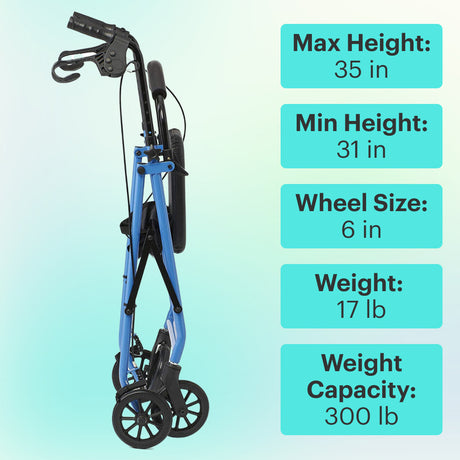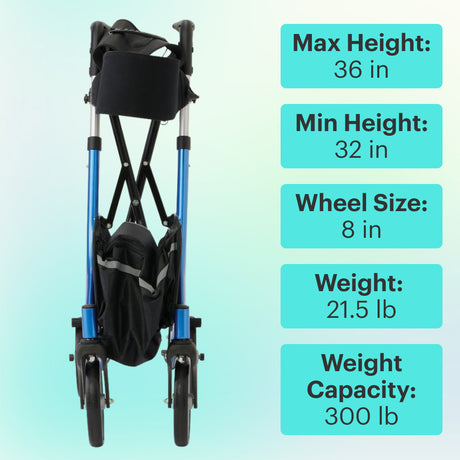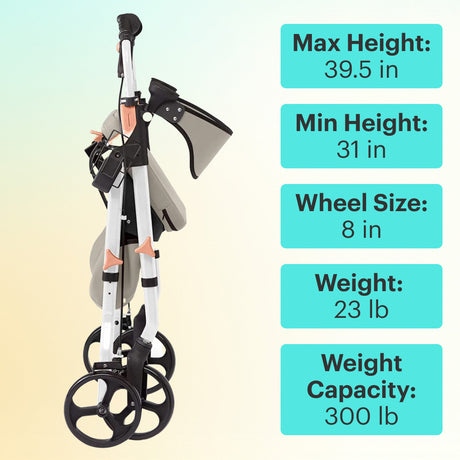Walkers can help individuals with declining mobility remain active and independent. To get the most out of a walker, people with mobility issues need to find an option that is right for their needs.
The height of walkers is one of the most important considerations, and many models have a height adjustment apparatus that allows users to set their mobility aids to the right height. In this post, we’ll explain how to adjust a walker to the correct height and why height matters so much for people who use walkers.
The Importance of Proper Walker Height Adjustment
The purpose of a walker is to provide extra stability to help those with mobility issues maintain their balance while walking. How tall a walker is will help determine how well it can perform this job.
The height of a walker impacts how easy it is to grip and move while taking steps. When a walker is set at the correct height, a user can maintain proper posture through their neck, shoulders, and upper back. A properly positioned walker also delivers more stability, so users can feel more confident.
Risks of Improper Walker Height
Using a walker frame that isn’t the right height for you isn’t a good idea for a number of reasons. When a walker is too short, it causes the user to become hunched over. The poor posture can put strain on the muscles of the back, interfering with comfort while walking and potentially causing soreness and pain. In addition, using a walker that is too short can cause a person to push the mobility aid too far ahead of them. This can make it more difficult to take small steps and stay balanced.
Walkers can also cause trouble when they are too tall. When a walker is too high, the user’s arms sit too high, and this can interfere with balance during movement. The position also stresses the muscles of the shoulders and neck, giving rise to discomfort. A too-tall walker can also lead to arm fatigue, and when this occurs, users may have a hard time continuing to walk.

Do Walkers Come in Different Heights?
Walkers do come in different heights. Manufacturers may refer to them by different terms, but here are the most common size names for general information purposes:
- Child and baby walkers: These walkers are intended for toddlers and children who are not yet done growing.
- Junior walkers: Junior walkers are generally for adults between 4’8” and 5’2” in height.
- Standard height walkers: Standard height walkers are usually suitable for people who are between 5’3” and 5’11” tall.
- Tall walkers: Tall walkers are available for people over 5’11” tall. Most have a maximum height setting and can accommodate users up to 6’4” tall.
- Bariatric walkers: A bariatric walker has a heavy-duty frame that gives it a higher maximum weight limit. It works for people who weigh over 250 pounds.
Although you can adjust the height of most walkers, it’s important that you choose one that is intended for your height because the amount that you can raise or lower the mobility aid is limited.
Types of Walkers
While we’re on the subject of walker height options, we should also mention that there are three main types of walkers available: rollators, walkers with wheels, and standard walkers. Read on to learn about the types so that you can decide which one is right for you.
Standard Walkers
A standard walker has two U-shaped tubes that serve as legs. Crossbars support the sides, and there are grips on the top of each side for users to hold onto as they walk. Most models have an arched bar and a straight bar that connects the legs of the walker in the front. The legs of a standard walker have rubber tips that provide traction to reduce the risk of slippage as you walk.
To use a standard walker, you must lift the mobility aid and set it down in front of you. Then, you step forward with the foot of your weaker leg, followed by the foot of your stronger leg.
Wheeled Walkers
Some people find it difficult to use a walker all day because of the need to lift the mobility aid. A wheeled walker offers a solution to this problem. Instead of having four rubber tips on the bottom, wheeled walkers only have two in the back. Front wheels take the place of the other two tips.
The addition of wheels allows you to simply push the walker a short distance in front of you. Then, you let the back two legs rest on the ground while you step forward to meet the walker.
Rollator Walkers
Rollator walkers take the wheeled design one step further with wheels on all four legs. With this type of walker, the mobility aid rolls along in front of you, and there’s no need to worry about lifting it. Most rollator walkers have brakes that you can use to lock the wheels when you want to stand in one place. Some models also have a seat that you can sit on when you need to rest and/or built-in storage for holding handbags, purchases from a store, and other items.
How to Determine the Proper Height for a Walker
To determine the proper height for a walker, enlist the help of a friend or family member. Once you have someone to assist you, put on the shoes that you normally wear when you go out to run errands or enjoy a fun activity.
Then, get into a comfortable standing position, maintaining good posture. Let your arms hang loosely at your sides and have your assistant measure the distance from your wrists to the floor. This measurement is how high the handles on your walker should be.
When a walker is set to the proper height, your arms should have around a 15-degree bend when you grip the handles. If your arms are straighter, the walker is likely too low. If there is a greater bend in your arms, the walker is probably too high.

How to Adjust Walker Height
The proper way to adjust the height of your walker will depend on the design. Most models have slots and telescoping legs that allow for tool-free adjustments, but there are walkers that have screws or bolts that you need to remove to make changes to the height. Read the instructions provided by the manufacturer, then do the following.
1. Locate the Adjustment Mechanism
On most walkers, the adjustment mechanism is on the sides of the legs. Locate the mechanism on your walker by referring to the manufacturer’s instructions.
2. Make the Adjustments
With slot-style walkers, you usually push a spring button and then slide the legs of the walker up or down as needed. Once you have the walker at the right height, you push the button into the corresponding hole on the legs. However, the way that you make adjustments for specific walkers varies, so refer to the manufacturer’s instructions.
3. Test and Readjust if Needed
Once you have the walker set, try taking a few steps. Pay attention to the bend in your arms and observe how your back, neck, and shoulders feel. If your arms are too straight or bent, or if you notice any tension, readjust as needed.
Walker Height Adjustment for Different Users
When adjusting the height of a walker, it’s important to keep individual needs in mind. Here are some tips on adjusting walkers for specific age groups and needs.
Finding the Right Walker Height for Seniors
When adjusting a walker height for your mom, dad, or another loved one, listen to their feedback. If you set a walker to a height based on measuring from their wrist crease to the floor and they say the walker is uncomfortable or difficult to use, adjust accordingly.
Although most people benefit from a 15-degree bend in the elbow, this is a general guideline that might not apply to everyone. Don’t simply insist that the size is correct if an older adult tells you that the walker isn’t working well for them.
Adjusting Walker Height for Children
Children may have a more difficult time communicating about comfort, so look for signs that they may be having trouble as they walk. Signs that the walker may be too high or too low include losing balance, taking unusually small steps, or struggling to lift or roll the mobility aid. Since children can experience sudden growth spurts, measure the child’s height regularly and adjust when needed.
Accommodating Users with Varied Needs
A person’s individual needs may impact the optimal walker height, and needs may change over time. For example, someone who recently had surgery and is unable to temporarily maintain proper posture may need their walker adjusted for a short period. A healthcare provider or physical therapist can provide you with individualized advice about setting walker height.

Maintenance and Troubleshooting
In order for any type of walker to be safe and useful, it must be in good condition. Read on to learn about maintaining and servicing walkers.
Inspecting the Walker for Wear and Tear
With regular use, walkers can suffer wear and tear. The rubber tips on the legs will gradually wear down, and wheels can become scuffed over time. Inspect the bottom of the walker regularly and replace tips and/or wheels when you notice wear. Also, keep an eye on the handle grips because these can break down as well.
Replacing Worn or Broken Parts
Whenever you notice wear, take steps to replace the parts. Some parts may need to be adjusted or replaced periodically. For example, you may need to occasionally tighten the brakes on a rollator to keep it working properly. The instructions included with the walker or rollator should include maintenance information and tell you where to order parts as needed.
Seeking Professional Assistance if Needed
When using a walker for the first time, it’s a good idea to have a doctor, physical therapist, or other medical professional check the height. If at any time you or your loved one experiences pain or discomfort while using a walker, seek professional advice.
For answers to questions about a specific walker, get in touch with the manufacturer’s customer service department. You should be able to find contact information in the usage instructions. If you can’t locate a phone number or email address, search for the manufacturer's website online.
Looking for mobility aids that are easy to adjust? Shop the line of rollator walkers available from Because Market today.














